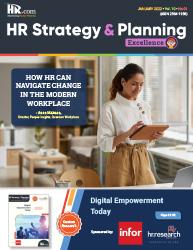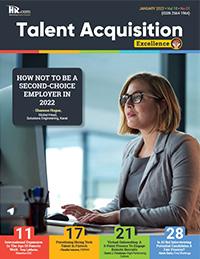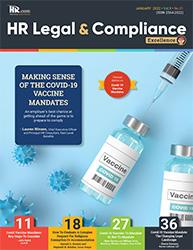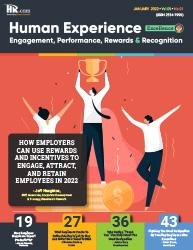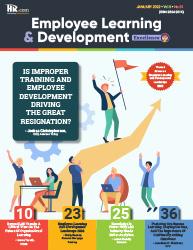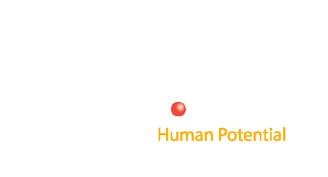






Strategies to cultivate a sustainable company culture



- Joe Camberato, CEO and Founder, National Business Capital
Create a better environment where all employees can thrive - Kelli Koschmann, Chief People Officer, Showpad

Create a happy and stable work environment - Davis Nguyen, Founder, My Consulting Offer
4 Ways Thinking Like A Comedian Can Ease The Transition Back To The Office
Don’t ignore the elephant in the room - David Horning, Founder, Water Cooler Comedy



The future is all about going beyond the employee experience to focus on human experience. This monthly interactive learning experience showcases strategies and programs to improve employee performance and strengthen your team.
Virtual Events in the Recognition and Engagement track will give you everything you need to recognize and reward employees creating an inspired workforce and organization that will drive innovation and boost productivity. Sessions feature the world’s top thought leaders in the recognition and engagement space covering topics from customer loyalty, safety, sales, company culture and motivation to what makes an effective and efficient results-based program. Each Virtual Event consists of up to 10 credit webcasts.
HR.com webcasts deliver the latest Recognition and Engagement industry news, research trends, best practices and case studies directly to your desktop. Webcasts are available live online with a downloadable podcast and a copy of the slides (PDF) available before and after each webcast. Earn all of the required recertification credits for aPHR, PHR, SPHR, GPHR, and SHRM Certifications. HR.com’s one-hour webcasts, in every HR specialty including HRIS and Payroll, are pre-approved for HRCI and SHRM credit (excluding Demo webcasts).
Join almost 25,600 HR.com members with a similar interest and focus on rewards and recognition. Share content and download research reports, blogs, and articles, network, and “follow” peers and have them “follow” you in a social network platform to communicate regularly and stay on top of the latest updates. This well established Rewards and Recognition Community is an invaluable resource for any HR professional or manager.
Our
Debbie
Dawn
Babitha
Chandra
Please send any
the
or
and
For customer service, or information on products and services, call 1-877-472-6648
letters
Human Experience Excellence (ISSN 2564-1999)
is published monthly by HR.com Limited, 56 Malone Road, Jacksons Point, Ontario L0E 1L0 Internet Address: www.hr.com
Copyright
debbie mcgrath Babitha Balakrishnan Editor, Human Experience Excellence
Babitha Balakrishnan Editor, Human Experience Excellence

The Covid-19 pandemic has greatly impacted how companies operate, and how employees perform their jobs. With employees leaving their jobs in droves and a majority of them not going above and beyond at work, there is a significant shift from the pre-pandemic years. Is this a sign of poor employee engagement?
As per a Gallup report, actively disengaged employees tend to have most of their workplace needs unmet and spread their dissatisfaction -- they have been the most vocal in TikTok posts that have generated millions of views and comments. Gallup finds a decline in engagement and employer satisfaction among remote Gen Z and younger millennials -- those below age 35.
The solution is loud and clear - If organizations want to retain and best engage their people, they need to pay more attention to the warning signs of quiet quitting. And the good news for employers is that there is plenty they can do to build an engaged workforce that goes the extra mile.
The October edition of Human Experience Excellence includes informative articles that discuss disengagement issues in organizations and strategies to re-engage employees.
SageX’s Heide Abelli in her article, Empower Quiet Quitters To Shift The Pendulum Back Towards Engagement, discusses the latest quiet quitting trend and warns talent leaders to act before productivity, quality of work, employee loyalty, commitment, and ultimately turnover are affected.
Fostering an engaging company culture in your workplace isn’t a quick and easy process. National Business Capital’s Joe Camberato in his article, Fostering An
Engaging Company Culture Is Not A Piece
Of Cake lists down a few ways in which organizations can cultivate a workplace culture that impacts employees on a personal level, which extends into the way the organization performs as a business.
To mitigate the trend of quiet quitting, employers need to consider an employee as a ‘whole person,’ according to Showpad’s Kelli Koschmann. In her article, What Companies Can Learn From Quiet Quitting, Koschmann talks about the importance of a healthier work environment where work-life boundaries are respected and the workforce’s well-being is at the forefront.
Are your employees back in the office? If not, give your people reasons to want to come to work. Water Cooler Comedy’s David Horning in his article, outlines how thinking like a comedian improves resilience, reduces burnout, builds trust, enhances communication, and raises retention rates to turn “I’ll quit if I have to go back” into “I get to go back!”
In brief, building an engaging company culture gives your team a sense of purpose and a reason to come to work motivated for success. Without it, you might become a revolving door of employees who leave and join without much tenure.
We hope you enjoy reading all the insightful articles in this edition and get back to us with your valuable feedback!
Happy Reading!
In a world of unparalleled challenges (global pandemic, racial injustice, politi cal rivalry, digital 4.0, emotional malaise), uncertainty reigns. Finding opportu nity in this context requires harnessing uncertainty and harnessing starts with reliable, valid, timely, and useful information. The Excellence publications are a superb source of such information. The authors provide insights with impact that will guide thought and action.
Rensis Likert Professor, Ross School of Business, University of Michigan

Partner, The RBL Group
Excellence publications are my ‘go-to’ resource for contemporary and action able information to improve leadership, engagement, results, and retention. Each edition offers rich and diverse perspectives for improving the employee experience and the workplace in general.



Author, Virtual /Live Keynote Presenter, Inc.’s Top 100 Leadership Speakers

I regularly read and contribute to Leadership Excellence and Talent Manage ment Excellence. I use many of the articles I read to augment my own presen tations and I often share the articles with my clients. They are always quick, right on target for the latest issues in my field, and appreciated by my clients.

If you want to stay up to date on the latest HR trends, choose a few of the dif ferent issues from the Excellence series of publications.


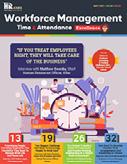
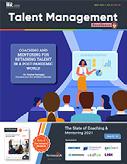

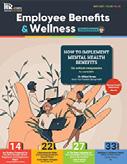
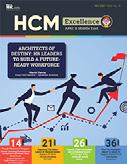


CEO, BevKaye&Co.

invest in employees, renew their sense of purpose, passion and growth
By Heide Abelli, SageXQuiet quitting, a workforce trend that first emerged over the summer ignited by a TikTok video posted by 24-year-old engineer Zaid Khan, has gained momentum with a Gallup Poll stating that more than 50% of U.S. workers admit to no longer going above and beyond at work. With workplace engagement

lowest among the youngest generations in the workforce, the ratio of engaged to actively disengaged workers is currently 1.8 to 1.
Khan’s definition of quiet quitting has resonated with millions of workers worldwide who no longer sub
scribe to the hustle culture mentality. Workers that identify with this newfound mentality have quit the idea of going above and beyond or having work rule their lives. With this rejection of hustle culture, em ployees have shifted their mindset, now prioritizing working to live instead of living to work
While I’m optimistic that this quiet quitting mentality won’t result in an entire workforce of the disengaged, this is absolutely a warning to talent leaders and businesses that should not be ignored. Quiet quitting evolved as a response to workers feeling burned out. Work has unquestionably become more intense since the onset of Covid-19. Pressure, stress and the 24/7 responsibilities of the job have resulted in widespread burnout. Organizations must draw the line and set boundaries. And the stakes are high. People disen gaging from their work is bad both for those individu als and for an organization’s bottom line. Given the negative downstream impact, talent leaders must intervene before productivity, quality of work, and em ployee loyalty, commitment and ultimately turnover are affected.
The health of the organization is at stake, but first and foremost, this is a people issue. What is most concerning to me and what should be concerning to leaders of talent, is that these people who are quiet quitting are giving up on developing themselves. They are not building careers or developing a calling or passion for their work. Instead, they are logging hours and collecting paychecks. Over the decades, I have managed and encountered countless colleagues and team members whom I considered to be unmoti vated, disengaged and not passionate or invested in their work. This has been an issue long before quiet quitting went viral. But given the scale of this move ment, talent leaders have to care about the trend, and they must also act.
To combat quiet quitting, talent leaders and manag ers must identify disengaged employees and begin empowering them to focus on building their careers vs. simply checking out. Managers will be critical in this process. It is the responsibility of managers to not only identify these behaviors but to correct them,

putting people on a path towards a career they feel worthy of investing time and energy in.
But most importantly, these disengaged workers need to feel a renewed sense of esprit de corps and mentorship. According to Gallup, since the pandemic, younger workers have felt significantly less cared about and have felt that they receive fewer opportunities to develop. This gives me serious concern, yet I am also optimistic that the pendulum of these feelings of neglect can swing back towards engagement, instilling a renewed sense of motivation and purpose. The importance of camaraderie and mentorship cannot be overstated, and our youngest workers are most prone to withdrawing if they don’t receive these opportunities for engagement within a community and professional growth. If organizations can provide their disengaged workers with the two things they need most, particularly for employees who spend the majority of their days working remotely—we will see a steady rise in re-engagement.
For managers that are hiring, I urge you to hire and cultivate people with conscientiousness. This personality trait will provide a safeguard to quiet quitting as employees who demonstrate conscientiousness are achievement-oriented, well-or ganized, persevering, methodical, self-disciplined and accountable. When interviewing, be mindful of how to assess conscientiousness in the candidate evaluation process. In interviews, ask candidates questions to determine conscientiousness traits, such as “Tell me about a time when you were really persistent” or “Tell me what strategies you use to organize your work,” and be sure to ask similar probing questions of the candidate’s references.

Conscientiousness can also be cultivated in employees. Managers should work with team members to identify any gaps in conscientiousness sub-traits and suggest training to help build specific skills that they are lacking. For example, if an employee receives negative feedback for being consistently disorganized, training in effective methods for organizing work should be a priority.
While the quiet quitting trend is a major concern and an unintended consequence of the increasing pres sures of work in the wake of the pandemic, I see this as a temporary setback. I’ve seen firsthand in my undergraduate business students the drive and pas sion that they possess and are eager to bring to the workforce.
While this will hopefully be a passing trend, it’s also one that won’t fade into the abyss if ignored. To shift the mindset of quiet quitters back to being motivated and engaged employees, we must invest in these individuals, renewing their sense of purpose, passion and growth.
Heide Abelli is an accomplished execu tive who has held senior leadership posi tions at leading educational technology and training providers such as Skillsoft and Harvard Business Publishing, where she developed award-winning, groundbreaking corporate training solutions. She is a seasoned veteran of product development, innovation and product management in the fields of corporate training and ed tech. Abelli is currently a teaching faculty member of the Boston College Carroll School of Management, an independent consultant in the ed tech sector and the co-founder of an entre preneurial venture in the training space called SageX.

Company culture has become more than a buzzword; It’s how businesses are fighting back against the Great Resignation. Employees want more than the bare minimum from their jobs, and the bottom line is about more than just the insurance benefits. They want to feel valued by their occupations, have flexibility in the workplace, and have an opportunity to get more involved in their work,
but this change won’t happen overnight—you’ll need to work at it consistently.
With long nights, careful planning, and consistent effort, leaders and teams can cultivate a workplace culture that impacts employees on a personal level, which extends into the way the organization performs as a business. My team and I took full advantage of

this approach early on and learned more along the way, earning us the title of #1 Top Workplace in 2019, 2020, 2021, and, most recently, 2022.
Fostering an engaging company culture in your workplace isn’t a quick and easy process, but the outcome is well worth your effort. It won’t appear overnight, and it isn’t something you can set and forget about, either. Company culture is a marathon, not a sprint, and you need to be actively involved in creating and maintaining your culture to ensure you’re exactly where you want to be.
Anyone can change their workplace. Here are a few ways how you can cultivate a sustainable company culture, courtesy of a #1 Top Workplace on Long Island:
First and foremost, you need to be willing to invest in your employees, both personally and professionally. You hired each member of your team for a reason. Maybe they had a sought-after skill, or maybe they’re just a very compassionate and charismatic person that won you over in the interview. Either way, taking a moment to invest in your team members strategically is a way to improve their quality of life and make them feel valued in the workplace, increasing their productivity and efficiency simultaneously.
You can do this in many different ways, like providing top-of-the-line technology to your computer-focused team members, but the best way to ensure your efforts result in a positive change is to ask your employees what they want. Taking the time to

ask them what they need not only gives them the resources they need to succeed but also makes them feel valued in your workplace, which can be priceless.
Valued employees lead to better results in all areas of your business, and, more importantly, the investment improves their lives outside of work as well. It doesn’t have to be complicated, either. Even something as simple as enrichment events, like fitness initiatives and healthy snacks in the kitchen, can show your team that you’re committed to their wellbeing. If you’re looking for a way to go above and beyond, you could take the investment a step further and offer learning opportunities to educate your team on important life topics, like financial planning and retirement investments. This isn’t necessary, of course, but it’s something that your team will appreciate you planning on their behalf.
Surely you’ve worked a boring job in the past. Think back to that time: Would you say that the less than stimulating environment you worked in contributed to you leaving that role? For many people, the answer is yes, as unexciting workplaces tend to have high employee turnover rates.
You can’t necessarily make the work of a data entry or assembly line job more enjoyable for the worker, but you can improve the environment around them and make it less of a drag. Put yourself in the shoes of the employee and take a look around the workplace from their usual position. Maybe you can make a visual change to give the employee a more vibrant setting, or you can institute contests between employees to keep the work fun and more engaging for the whole
team. If everyone gets involved, it can quickly become a historic moment for your team members. They’ll always have the memory that you’ve created, and they might be more willing to participate in similar activities in the future because you’ve broken the ice.
Workplaces don’t have to be enjoyment-free zones where everyone comes to work and merely survives until the clock strikes 5 pm. Unfortunately, most modern workplaces tossed fun to the side years ago to focus on performance and results, but what if you could achieve both amazing results and the utmost performance while still having fun?
You don’t have to go overboard with fun activities to see results. In fact, it’s often a careful balance of that work/play lifestyle that yields the best outcome. Out-of-office events, like company happy hours and events, are great for giving your team an opportunity to talk outside of the normal work topics, but don’t forget about in-office events, too! Ending work early on a Friday to run a team-building game with your office could be what you need to increase your employee engagement. Plus, in most cases, it won’t cost you very much!
Leadership roles are one of the most important positions in any company. The leaders below you are an extension of your voice, ideas, and influence, so you should make sure to choose these individuals carefully and support them throughout. They shouldn’t be a sort of secret police that is looking for people acting outside of the cultural standard; Your team should be responsible for ensuring that the systems you’ve implemented are running smoothly and completely. Basically, they’re an extension of yourself, so make sure to staff your team with individuals you know you can trust.
Leadership teams are essential for company culture, but you’ll need to consistently meet with your leadership team to ensure that you’re still involved in the troubleshooting process. The size of your team often dictates how frequently you’ll meet to discuss
the cultural component of your business, so make sure to put this review on a schedule that works for your organization.
company culture could Be a game-changer in Your Business Engaging company cultures gives your team a sense of purpose and a reason to come to work motivated for success. Without it, you might become a revolving door of employees who leave and join without much tenure, which is why company culture is no longer an optional expense in our modern business culture; It’s a necessity if you want to keep your team and operate at the highest efficiency.
However, don’t expect your company culture to magically appear overnight. Even with the strategies above, fostering a positive company culture will require you and your leadership team to constantly work and focus on the initiatives you’ve set into motion—you can’t just set and forget it. Once you find the right balance, you’ll be surprised at the level of productivity you can achieve, and your employees will be sure to thank you for it, too!
Joe Camberato is the CEO and Founder of National Business Capital – the leading fintech marketplace, helping entrepreneurs access competitive financing fast, through an easy-to-use online platform and experienced team.

Employees want more than the bare minimum from their jobs, and the bottom line is about more than just the insurance benefits.
Recently, the Wall Street Journal published an article titled, “Americans Are Breaking Up With Their Work Friends.”
As workplace friendship champions (like knights in shining armor but with less chainmail and more rainbow unicorns), our immediate response was a bit of alarm.
After all, we just wrote a book about making friends at work, You, Me, We: Why We All Need a Friend at Work (and How To Show Up As One!).
But the truth is, people are messy.
Whether we like it or not, each of us has the potential to be an emotional Pig-Pen. Our emotions, conflicting perspectives, and insecurities can follow us and our relationships around in a cloudy mess more difficult to clean up than the real Pig-Pen himself.
So even though you may have learned “make friends, make friends, never ever break friends” on the playground, it isn’t always applicable to workplace relationships. Sometimes people are too much.

here are seven signs that it might be time to break up with your work buddy.
1. They are a work vampire.
They don’t communicate with respect.
They aren’t supporting you like you support them.
They’re bumming you out.
They don’t respect your boundaries.
They don’t take responsibility.
They aren’t reliable.
If you work in an office (even remotely), then you know Bram Stoker’s Dracula isn’t nearly as scary as that one coworker who will casually drop in and steal an hour of your life away without even blinking.
But work vampires aren’t always as obvious as the nonstop talker at the office. Sometimes, it’s someone who consistently takes a little more time, a little more effort (emotional or otherwise), and a little more work than everyone else.
If you feel drained after every interaction you have with your work friend, it might be time to reevaluate your friendship. Being an ally friend doesn’t mean you have to give everyone what they want. There’s a difference between practicing abundance and generosity and having your time and energy sucked out of you.
What words does your workplace friend use when talking to you? What words do they use when talking about others? Do they value differences of opinion or belittle those who think differently?
There’s nothing wrong with disagreement.
Direct, honest conversation is critical to an ally relationship. It’s why candor & debate are one of the five essential practices of the Ally MindsetTM we share in our book.
But candor & debate aren’t rudeness, insensitivity, or verbal discrimination. There’s a difference between giving candid feedback and disparaging someone else’s viewpoint, abilities, or opinions.
Respect is critical to a healthy friendship. If you’re receiving insults, needless criticism, or patronizing arrogance, it’s time to reevaluate.
And if they’re respectful to you but outright awful to others, it may be time to consider how their communication is affecting your reputation and, more importantly, your behavior.
One of the most beautiful gifts of an ally relationship (aka. friendship) is feeling supported. In You, Me, We, we asked how you know when you’re in the presence of an ally. Here’s what we said.
“They have the same goals you have. They are happy to be your sounding board, listening intently to your ideas and suggestions for improvement. They work with you instead of against you. They’re straight shooters; they tell you the unvarnished truth. They always have your back.” - Us, in You, Me, We
Hopefully, this accurately describes you. (If not, buy our book!) But if you consider your friend to be an ally and they don’t treat you like this, then they may not be the friend you think they are.
Not everyone in your life will be an ally, and that’s okay But it’s important to recognize who is and isn’t an ally to you, even if you still choose to be an ally to them.
In the early 2000s, SNL aired a series of skits about Debbie Downer, played by Rachel Dratch. The character fit her name perfectly. No matter what joyous event was happening around her, she always found something negative to point out, even when it made the people around her visibly uncomfortable.
Unfortunately, there are people like that everywhere. They may not have Debbie’s trademark “wah, wah” sound to warn you of their negativity, but you know how you feel after they’ve left. The complaining, problem-focused mentality and general unhappiness present in every conversation can make it challenging to keep your own spirits up.
If you internally brace for conversations like you’re about to be hit by a 250-lb bag of sadness, then it may be time to consider if the upside of your friendship is worth the discouraging downside of their negativity.
No is an important part of any healthy relationship. You can only give to others as much as you’re giving to yourself.
And unless you came here in a spaceship from the planet Krypton, you aren’t going to be able to do everything you’re asked and still have time for yourself, which means you’re going to have to say no to some things.
Allies view boundaries as a healthy, positive part of any relationship and will not only respect them but will encourage you to create them when needed.
On the other hand, a friend who hears your no as a maybe (or worse still, a yes) isn’t being an ally at that moment. If they consistently trample on your clearly expressed boundaries, then it might be time to reevaluate your friendship.
We all make mistakes. It’s human nature. It’s also a valuable part of how we learn and grow. When we take responsibility for our actions, we give ourselves the opportunity to become better.
Unfortunately, not everyone sees the value in taking ownership when things don’t go according to plan (in technical terms, it’s known as “the $*#t hitting the fan”).
These arrogant jerks assign blame to anyone and anything except themselves when things go wrong. Rather than learn and grow, they deflect and blame, sometimes at the expense of their friends.
Yes, it can be hard to own up to our mistakes and take a long, hard look in the mirror. But if your friend plays
a world-class blame game, you may soon find yourself on the receiving end of their deflecting.
The last practice in the Ally MindsetTM is action & accountability, the “just do it” part of the model where you move beyond mindset to make choices. Good intentions are admirable, but good follow-through is where reality happens.
Allies keep their word. They do what they say they’ll do when they say they’ll do it. If they say they’ll send you a report, it’s in your inbox by the deadline. If they say you can call them anytime, you know they’ll pick up when you call at 9:30 pm.
Trusting that your friend will follow through on their word is critical to a healthy friendship. We all have off days where we forget or experience an unforeseen crisis, but if your friend is consistently unreliable, they may not be the friend you want them to be.

Sometimes, a work “friendship” isn’t a true ally relationship and needs to be ended. Being an ally to yourself first sometimes means letting go of a relationship that will damage you.
But off-track friendships don’t always need ending. Sometimes, they just need recalibrating. We aren’t always aware of how our actions affect others, and your friend may not understand just how their behavior is negatively impacting their relationship with you (or their own career success!).
In a recent study, Dr. Tasha Eurich discovered that there are two types of self-awareness, internal (knowing how we see ourselves) and external (knowing how others see us). Most of us are better at one type than the other.


If your friend struggles with external self-awareness, consider being their ally and sharing some candid feedback. As Dr. Tasha shared, “ …we found that people who improved their external self-awareness did so by seeking out feedback from loving critics — that is, people who have their best interests in mind and are willing to tell them the truth.” Sounds like an ally, right?
Most people don’t get up and decide they’re going to mistreat their friends. We all want connection and generally strive to be a good friend. Sometimes we just have different ideas of what being a good friend is.
It takes work, but clearly communicating expectations and restating boundaries can often pivot an unhealthy relationship back into ally territory.

We all have misperceptions of each other. Opening up the lines of communication offers both of you a
chance to not only mend your relationship but also deepen it in a powerful way.
And if your friend doesn’t respond well to your attempts to recalibrate, then you can make a conscious choice to change your relationship status without ghosting, awkward break-up texts, or toxic fallout. You will both be aware of what happened and can amicably go your separate ways. Best of all, you’ll know that you’ve been an ally even in the way you leave.
Being an ally isn’t always Easy, but it’s always worth it.
Being an ally doesn’t guarantee relationships will always go smoothly. Sometimes you’re going to feel like Charlie Brown going after that football and ending up on your back (thanks, Lucy).
But if you want to build workplace friendships that can dramatically improve your work and life, then the obligation is on you. It’s up to you to be an ally, even in your most challenging relationships.
And unlike Charlie Brown, when you give people the chance to change, sometimes they do! You might be surprised at just how far you can kick that ball when you kick it together.
Morag Barrett is the CEO of SkyeTeam, and a sought out executive coach and member of the Marshall Goldsmith 100 Coaches organization. Eric Spencer is the COO of SkyeTeam and is passionate about developing high-per forming leaders and teams. Ruby Vesely is a valued executive coach and facilitator. Together, they are the heart of SkyeTeam, an international leadership development firm and the Co-authors of You, Me, We: Why We All Need a Friend at Work (and How to Show Up As One!)
create a better environment where all employees can thrive
By Kelli Koschmann, ShowpadQuiet quitting is not a new concept; at the very least, the term may be nuanced, but the reasons behind it have been snowballing for some time. Being overworked and under appreciated, while also being expected to contribute more, is a
characteristic that unfortunately still continues to prevail across many workplaces.
However, after the turmoil of the pandemic, which has seen many employees reassess their priorities, there has been a
seismic shift in the approaches to and expectations of work.
Companies must remember that the employer-employee relationship is symbiotic; when there’s a breakdown on either side, the result may be disengagement

– and ultimately quiet quitting. But companies can learn from this and evolve their practices for the better. Often it’s a case of understanding the motivations behind quiet quitting, elevating the employee experience, and incorporating training for all employees that enhance the application of empathy.
Companies must look at employees as people they want to invest in, and then must aim to grow and develop their talent. After all, employees are the heart of any organization. Quiet quitting impacts the individual in question and the business as a whole. When a company is focused on acquiring top talent, and that talent begins to see their colleagues quit, it can be demoralizing for other team members and damage
their workplace community. A good manager should notice the disconnect quickly and work to support the individual to evaluate the reason behind their withdrawal. Employers need to be heavily engaged in the employee experience across its entire lifecycle.

companies must look at employees as people they want to invest in, and then must aim to grow and develop their talent.
There is generally an unwritten contract between employer and employee, defined as ‘the give and the get,’ which is a combination of two things: what the employee
gives in return for what they receive from an employer and vice versa. When the give and the get break down, perhaps because an employee feels an expectation wasn’t met or there was a breach in the give-get contract, it can culminate in employee inertia. Employees begin to wonder whether the role is working for them. In some cases, they might check out or find another job.
Companies should drive understanding of the employee experience through the deployment of data, as well as working on qualitative and quantitative employee listening methods. This will provide a good pulse on how employees are feeling and allow the company to pivot accordingly if there is a sense of workforce unease or dissatisfaction. Proactivity at this level is essential to nipping issues in the bud and ensuring the
employee experience is rewarding and long-lasting.
Employees may not be actively disengaged from their jobs, but factors in their lives compel them to do so. Quietly quitting isn’t always an active decision; sometimes, it is a coping strategy due to other life events beyond employees’ control. However, motivation comes from within. If that piece is missing for an employee, even if their employer is creating an optimal employee experience, companies might need to take extra steps to create a safe space.
Notions of quiet quitting connect to themes of languishing and evoke the mental health challenges that have shaped the last few years for many of us. With a global news agenda shaped by themes of war, economic crisis, political turmoil, and the pandemic, many employees are carrying a heavy psychological burden that can prompt them to shut down and disconnect from work. When confronted with these cases, organizations should be mindful of correlations between mental health and burnout. Considering the extenuating circumstances framing an employee’s approach and attitude toward their work ethic is imperative.
The rise of quiet quitting suggests more employees are coasting at their jobs than ever before. Coasting and intentionally not
performing could also impact career networks, cost employees strong references and, ultimately, their livelihood. The reasons and circumstances behind quiet quitting are not always visible to the naked eye. Mental health can play a prominent role in feeling overwhelmed and can dissolve an employee’s coping ability and cause an unconscious quiet quitting. When companies realize this may be the case, they need to take proactive steps to help them. Whether it’s providing additional mental health support or recommending time off, employees coping with these feelings need to feel supported and heard.
Soft skills like empathy and resilience are no longer exclusive to leaders, and instead need to be continuously developed at all levels in the workplace. Empathy plays a critical role in employer and employee exchanges and experiences. For example, adaptivity and resilience training courses that look at what we all need to grow as humans can benefit all employees. These training courses can help managers better pick up on nonverbal cues that showcase how employees feel about their job and their experience at a company. This enables the employer to tune into what type of support each employee needs.
Essentially, this practice goes back to employers showing up as good listeners who are invested
in their employees, committed to cultivating a sense of community and belonging, and who prioritize career development. While we all go through peaks and troughs of exciting work, a good employer should ensure that all types of work are enriching overall. If an employer isn’t cognizant of this, it’s incumbent on the employee as the master of their career path to step up and push for variety and growth.
To mitigate the trend of quiet quitting, companies need to consider an employee as a whole person. By doing so, companies create space for employees to adapt to current circumstances and accommodate their personal and professional journeys. Creating a healthier work environment where work-life boundaries are respected and the workforce’s well-being is at the forefront of its values helps create a better environment where all employees can thrive.
Kelli Koschmann is the Chief People Officer at Showpad.
Would you like to comment?







Nearly 70% of executives believe improving how employees feel at work leads to increased productivity and performance. This is one of the key findings of research from HR Solutions provider Adecco Group and the University of Zurich’s Center for Leadership in the Future of Work.
It is just the latest in a growing body of research that points to the importance of culture in attracting, retaining, and engaging employees. It is now well understood that culture drives engagement and engagement drives performance.
Throughout the pandemic, successful organizations were able to rely on a strong culture to help people stay connected not just to each other but to a shared sense of purpose. Now that the pandemic is transitioning to endemic, organizations are shifting to permanent fluid working arrangements, with employees working at least in part from home, at the office, and on the go.
By the end of 2023, Gartner predicts that 40% of organizations will blend virtual and physical experiences. This wasn’t the expectation in 2020 when the pandemic forced businesses around the globe to shift almost overnight to remote work.
The thinking, especially among the largest employers, was that once the pandemic was under control, employers would return to the traditional work environment and work would happen much as it did pre-pandemic.
We now know this is not the case. The effectiveness and productivity of remote work coupled with the ‘Great Resignation,’ the skills shortage and workers’ re-evaluation of priorities have given employees a stronger voice – and they’re using it to set new standards when it comes to when, where and how work happens.
According to a Gallup survey of more than 140,000 U.S. workers in the U.S., 53% expect a hybrid work environment going forward; 90% like at least some degree of remote-work flexibility; and 60% prefer hybrid work. A flexible work environment is more than nice to have. Nearly half of all respondents (46%) are willing to quit if they can’t work either fully remote or in a hybrid model.
Even before the pandemic, the role of human resources professionals was evolving away from administrative tactics to strategic partnerships, shaping corporate culture to drive performance
in a fast-changing environment, where employee expectations go well beyond competitive compensation. Today’s workers are looking to find meaning, purpose, and a sense of belonging at work, in addition to flexibility and career advancement opportunities.
Over the last two years, the HR community had to step up to help workers manage feelings of anxiety, isolation and burnout resulting from the sudden shift to remote work, while building a sense of connection virtually. Now that virtual connection is the new normal, Chief People Officers are tasked to ensure organizations can meet employee expectations and keep their people connected and productive wherever they are.
Forward-looking leaders understand culture will be key. In fact, recent reports confirm that maintaining corporate culture has become a top concern for business leaders when it comes to managing hybrid workforces.
Now it’s up to HR professionals to find the right solution for their organization. Leaders are developing strategies that empower teams, deliver immersive hybrid experiences, and enhance a strong corporate culture that transcends location and drives results. How? With high touch and high tech. Specifically, people managers are doing a deep dive into their people, how they like to work, rethinking workflows and workspaces and integrating collaborative technologies to accommodate flexibility and thrive.
● Understand your culture. Culture is how your organization does things. It’s what sets you apart from competitors and it can only thrive when your people buy in. Talk to your people. Pay close attention to the behaviors that make individuals and your organization successful. Find out preferred workstyles and align with what the business requires. This will help you determine workflows and a plan for your unique hybrid

model. Be prepared to adapt as you begin to see what works and what doesn’t.
● Decide what you want to achieve in-office and what can happen anywhere. Once you know the business objectives and how best to deliver them, then you can start to identify the tools and office design that will optimize performance while enabling collaboration, creation, and content sharing.
● Integrate collaborative technologies. Prioritize virtual. This will help ensure that no matter where people work – in the office, at home or mobile, or a mix of the three – interactions feel natural, as though everyone is physically together. It starts with seamless connectivity and ensuring meeting spaces foster collaboration. Collaborative technologies are more accessible than ever today, from AV and IT technologies that support hybrid work to interactive displays and advanced whiteboarding software, high-definition videoconferencing screens with integrated webcams, and portable displays that can go anywhere, creating a simple dual monitor set-up. The goal
is to ensure everyone has the tools to be fully productive from anywhere.

At the core of this transition is culture. Research from McKinsey reveals that 70% of employees say their sense of purpose is defined by their work. Corporate purpose is at the heart of culture. In a fluid work environment, it’s more important than ever to connect people to purpose – and that means connecting them. This is what will give them a reason to stay.
Vincent Chou is the Director of HR for ViewSonic, a leading provider of interactive and collaborative visual engagement solutions for enterprise, education, consumer, and commercial markets.

In a tight employment market, it may seem that no one wants to work for your company. Turnover is costly and disruptive. It’s especially important today to keep good staff from leaving -- because the right talent can make or break a company’s ability to succeed in an increasingly competitive marketplace.
In my experience as the founder of My Consulting Offer (a program that helps people land their dream jobs in management consulting), I have discovered
these helpful tips on how you can avoid losing the people who make your business run smoothly:

Make sure your team knows you value them!
This shows itself through a variety of ways, like performance reviews (where their accomplishments are publicly recognized), timely feedback (especially praise when warranted), encouragement when needed (great ideas should be rewarded), cost-of-living raises (in line with or above what other area employers
create a happy and stable work environment
offer), and special company perks (tickets to events around town, gift cards, free food).
Make sure your employees have good pay and benefits, as well as opportunities for advancement. You want your team to feel like they’re valued members of the company family! And this should include contractors as well. Clients and vendors come and go, but our team is here to stay.

Negative reinforcement may get results in the short term – but it will ultimately backfire. Don’t intimidate your employees – this will only create an ‘us versus them’ mentality and sap morale.
One difficult lesson I’ve learned is that team members need to know what’s going on “behind the scenes” in order to feel good about where they work and how their job fits into company plans. It’s important for management to convey a clear message about the direction of the business as well as its growth potential, especially when those things change with time (which they undoubtedly will).
This creates both loyalty and experience, building up your bench strength for future changes or staffing shortages down the road.
This is important for better decision-making about your business in general, and also critical to keep
abreast of new job opportunities that might be available once employees gain more experience with newer technologies.
Work culture is paramount for employee retention. Make your business’ workplace more fun by having events like a game or movie nights (or free food), de-stress sessions at the end of the week (for example, yoga classes or group walks around the building), team outings (bowling, mini-golf, paintballing, etc.), picnics in a nearby park... the list
By making your team feel like they’re part of the family and keeping them in the loop, you can avoid turnover by having a happy and stable workforce. However, one big mistake business leaders make when addressing employee retention is turning a blind eye and ignoring the problem (otherwise known as ‘sweeping it under the rug’). By leaving a bad situation to fester until it becomes unmanageable, you alienate your team and erode the trust necessary for your business to succeed.
Davis Nguyen is the founder of My Consulting Offer, a top program that helps people land their dream jobs in management consulting. Davis started My Consulting Offer as a weekend side business in 2017 and, within a year, grew it into a six-figure side business without spending money on marketing. After becoming a full-time entrepreneur in 2018, Davis has helped over 500 people launch careers in consulting, grown his business to seven figures, and was featured at TEDx.

Show that management values the importance of the HR function, and has a commitment to development and improvement of HR staff.
Ensure that each person in your HR department has a standard and consistent understanding of policies, procedures, and regulations.
Place your HR team in a certification program as a rewarding team building achievement.
Certified HR professionals help companies avoid risk by understanding compliance, laws, and regulations to properly manage your workforce.
HR Professionals lead employee engagement and development programs saving the company money through lower turnover and greater productivity and engagement.
A skilled HR professional can track important KPIs for the organization to make a major impact on strategic decisions and objectives, including: succession planning, staffing, and forecasting.

In the era of remote and hybrid work, many employers have shifted away from traditional, in-person wellness programs by adopting digital alternatives. With programs moved online, can employers ensure they are driving employee engagement to achieve their wellness goals? They can. However many organizations and employees are not sure where to start with digital wellness.
The challenges people face on their journey to wellness are multifaceted, yet they share a common thread: these roadblocks can often act as deterrents, preventing employees from seeking out the help they need. Overcoming these barriers to receiving care, is the first step in seizing the opportunity to help employees to achieve lasting health outcomes. By eliminating these common barriers to digital wellness engagement, organizations can have healthier workforces and employees can be empowered to take focused action to realize health improvements and better habits.
Whether striving to manage chronic health conditions or improve stress, sleep, nutrition, physical activity, or reduce substance use, one of the greatest challenges providers across the board face is engaging participants in treatment plans. For digital programs,
this engagement obstacle can be even more challenging to overcome, especially when lacking a personal touch. Our research shows that by engaging participants in one-to-one health coaching, their plan adherence and program/course completion rates increase dramatically—by 112%.
This is proof: the power of communication and collaboration to drive behavioral change cannot be underestimated. Harnessing technology, digital platforms can deliver personalized experiences and leverage the human connection linked to successful participant outcomes. They can make a connection and deliver personalized care when and how your employees want and need it.
As more than 50% of U.S. adults live with a chronic condition and workers report increased rates of stress, anxiety, and burnout, scaling this high level of care has never been more critical.
In the past, it simply wasn’t possible for providers to oversee continuous support at a high level. Automation is key to realizing engagement at scale. Take automated conversations for health and wellness coaching, for example. This offers employees 24-7 access to answers, education, and
encouragement no matter when they are accessing care or need a boost the most. Throughout a program, and in the event a coaching session is missed, automation can ensure participants don’t fall through the cracks. Platforms offering a hybrid of human coaching and digital communications can automatically send emails, texts and coaching talks to prompt rescheduling; reach out on a participant’s preferred weekly or monthly basis for a touch base, and follow up upon program completion to offer added support.
Personalization tied to a person’s health priorities and care paths should start at the onboarding process and filter into every aspect of a wellness program’s delivery through completion. Digital platforms taking a personalized approach to care allow employees to take self-paced cognitive training courses, gain access to relevant content, track progress, and check off short- and long-term goals as they accomplish
them without added noise that’s not specific to their goals. But not all digital wellness platforms are alike. You want to find one that offers templates or easy ways for the benefit and corporate wellness teams to get a jump start on building personalized options for employees.
Having the ability to scale programs that both meet the needs of the organization as well as the participants is key to success. By ensuring all content and communications are impactful, timely, and delivered to participants when, and how, they want it, programs can engage people in a way that fosters action.
From an employee standpoint, time is one of the greatest barriers to effective care. Digital wellness solutions eliminate this obstacle, giving employees quick, seamless access to the care and support they want, whenever and wherever they need it most.

Personalized care blending human care teams with an expansive, online library of microlearning videos, podcasts, and articles mean workers can access their personalized content when and where it’s convenient.

Recently, Mental Health America’s Mind the Workplace 2022 report found that although 3 in 5 employees said their managers care about their well-being, only 2 of 5 were encouraged to take time off when it was needed. What’s more: while almost half of the workers surveyed were informed of their company’s mental health services, only 38% were comfortable making use of the help.
Whether working in-person or in a hybrid or remote capacity, employees need to feel supported while also being able to maintain their privacy. Achieving this begins within the company culture and can be realized through discreet digital wellness tools. Employers can eliminate the stigmas attached to receiving mental health and wellness support, encourage employees to take time off when it’s needed, and provide digital wellness programs that not only adhere to laws protecting private health information but also give employees the tools needed to make lasting change.
Employers are in a unique position to turn these obstacles to digital wellness engagement into

opportunities to help their employees make improved mental and physical well-being an achievable goal. Advanced technology platforms delivering personalized care can break down barriers and boost employee self-efficacy, which helps increase engagement and empower change. By providing tools that personally engage employees in their health care and wellness journeys, employers can positively impact the quality of care to improve their overall experience and health outcomes.
Clark Lagemann is a seasoned entrepreneur and wellness industry leader on a mission to help health coaching teams engage better and coach smarter. As CEO of Avidon Health, a 2022 Inc 5000 company, he leads a team of behavioral change experts to provide innovative coaching solutions that personalize engagement to create behavior change at scale.
After nearly three years of remote and hybrid work, a mandatory return to colocation isn’t exactly being met with universal enthusiasm. With the return of the commute imminent, it seems employees fall into three different categories:
1. I’ll go back if I have to.
2. I’ll quit if I have to go back.
3. I get to go back!
In an ideal world, all of your team members will fall into group three. In the real world, most fall into groups one or two. With quit rates hovering right around 3% since the beginning of “The Great Resignation,” and Gallup reporting that half of the American employees are “quiet quitting,” a smooth transition back to the office is vital to the retention and
engagement rates, and thus the bottom line, of your organization.
The billion-dollar question is “How?”
My response: think like a comedian.
Seriously.
Many of the skills necessary to be a successful stand-up comic run parallel to the problemsolving and people skills needed to be a successful leader in today’s workplace. In this time of transition and uncertainty, leaders who learn to “think like comedians” and effectively apply the tenets of humor will set themselves apart as great leaders by making the return to the office feel less like an obligation and more like an exciting new opportunity.
1. address, don’t ignore the Elephant in the room
Your people are going back to the office and most of them probably aren’t looking forward to it, but acting like none of this is happening is insulting at best, and costing you money at worst. Imagine you’re onstage at the Comedy Cellar and the table in the front loudly heckles you. If you don’t address the heckle adequately, not only will they keep heckling, other tables will either join them in heckling, or they’ll start a conflict with that first table, and your set will snowball out of control.
By acknowledging your realization that not everybody may be on board with the return-to-office policy, you position yourself as being in the same boat as your
team. Attempting to appear as though it’s “business-as-usual” when it’s anything but is a great way to betray your people’s trust and frustrate them even more. Address that elephant and ask for input and ideas for a smoother transition to make the experience feel more like a shared one.
2. frame the return to work as an opportunity, rather than an obligation One of the most interesting tools in joke-writing is the ability to frame a particular topic as something else altogether like John Mulaney’s “horse in a hospital” bit from his 2018 Netflix special “Kid Gorgeous.” He took a politically charged topic (Trump becoming president), framed it as something we’ve never experienced before (a horse somehow getting loose
in a hospital), and delivered an objectively funny piece of comedy, regardless of ideology.
How does this apply to the return-to-office?
Ask your employees, whether it’s in a survey or in one-on-ones, what they missed most about being in the office and what they would do to make working in the office an even more enjoyable experience. If you hear the same responses over and over, that is what your return-to-work messaging should be centered around, not the work itself. Then, when everyone is back working together, you better follow through on the feedback.

3. present the colocation as an Experience, and not Just a place
You know the adage “That meeting could’ve been an email?”
Now that your team has tasted the freedom of being productive remotely, the last thing you want people to think is “That work could’ve been done from home.” If you’re committing to a hybrid style of work, make sure the days in the office are filled with the types of brainstorming meetings, team-based exercises, and chance encounters that didn’t translate via Zoom.
Yes, you can enjoy watching stand-up comedy alone at home, but there is nothing like being in a room full of people laughing together that amplifies the experience. The same is true of your workplace’s culture. Give your people reasons to want to come to work.
If you’re requiring a 5-day, in-person workweek, Monday
morning all-hands meetings can be so much more dynamic by starting with improv games, opening with interesting conversation starters, or by sharing funny stories about the weekend before getting to work. It turns out, the simple act of laughing together as a team before solving problems will make you 28% more effective (University Of Maryland).
You’re back at The Comedy Cellar performing the same jokes you’ve done hundreds of times to raucous laughter, except tonight, you’re getting nothing but crickets. You have two options:
1. Stay the course and blame the audience.
2. Call an audible and see what happens.
Once, I watched one of my favorite comics bomb for a solid seven minutes, stop his set and ask the
audience what was happening. It turns out, a party of 20+ tourists from Denmark made up more than half of the audience and many of his cultural references were going right over their heads. The moment he made this realization, he joked about how they all looked the same, which got a laugh. Then, he pivoted to asking them what they thought of New York City, he had punchlines for everything they brought up, it felt more like a dialogue than a stand-up set, and it gotthe rest of the audience invested.
When a comedian leads with curiosity, they make unexpected discoveries that have the power to bring a room full of strangers together in a shared experience. As a leader, if you sense any resistance, get curious, ask questions, and listen to the answers you get. Your curiosity will open you up to unexpected discoveries and new ideas while giving your people an increased sense of ownership and meaning in their work.
As you return to the office, these are just four ways that thinking like a comedian can improve resilience, reduce burnout, build trust, enhance communication, and raise retention rates to turn “I’ll quit if I have to go back” into “I get to go back!”

David Horning is the founder of Water Cooler Comedy and a member of Peppercomm’s Laughing Matters Council, a collective of business and humor experts working to enhance understanding of the power of humor to build teams, improve leadership skills, create strong corporate cultures, drive innovative thinking, enhance employee well-being and more.

gratitude can fuel employee engagement and significantly improve company culture
 By Scott Johnson, Motivosity
By Scott Johnson, Motivosity
The workplace has changed wildly in the past few decades. The business world has increased its focus on healthy company culture, appreciation for hard-working employees, and giving back to those who give so much of themselves to further company missions. It is no secret that engaged employees are productive employees. Recent studies show high employee engagement can lead to upwards of a 22% improvement in productivity. How leaders engage their employees can vary, but data from the 2019 Workhuman Analytics and Research Institute (WARI) report shows that gratitude is a secret weapon when it comes to creating an engaged, resilient and stress free-workplace.
Showing gratitude to your team can be much more straightforward
and inexpensive than most may believe. It doesn’t take a kitchen stocked with the latest trendy snacks or a huge budget for company swag to show gratitude. Instead, focus on building a grat itude-centric environment where employees feel seen, heard, and appreciated regularly - it’s such a more impactful way of motivating and inspiring employees to be their best.
There are plenty of ways to introduce the concept of gratitude in the workplace. Traditionally, we’ve seen “Employee of the Month” awards or MVP
recognition for certain employees. Sure, these can be wonderful ways of recognizing top-notch performers, but they may not be enough to make a meaningful difference within your team. Think of all the productive team members that are left out of that kind of recognition! Frequent, peer-to-peer recognition can help employees feel more appreciated and connected to one another. It can also create a “pay it forward” effect, where employees are more likely to show gratitude to one another if a culture of recognition and thankfulness for a job well done is created.
Within many of the employee engagement tactics enacted today — for example, team building games or group outings — there lies an element of good intention. Essentially every employee engagement that companies launch is well intended. Team building games, group outings, collaborative meetings are all examples of approaches that aren’t inherently bad, but they lack one key component: purpose.
When leaders set out to create an engagement strategy, they must think about their “why?” What is the purpose of the strategy, and what do they hope to achieve? Is it simply to keep employees happy in the short term, to get them through a particularly difficult season or quarter, or are you looking for lasting change within the organization?

Creating a plan that includes a heavy focus on gratitude leads to impacts most companies are thrilled with. This gives employees a path toward connectedness which truly leads to retention and high performance.
Weaving the concept of gratitude into the day-to-day actions of the organization is not a job solely meant for HR departments. Executive teams can’t be the only ones responsible either because there’s too much happening and not enough time in the day to recognize all the wins. Gratitude and recognition should be a company-wide effort. Executives,
managers, and employees alike should all participate in creating a company culture that buoys ideas of acknowledgment and appreciation for what each person brings to the table. You’ll see faster and more obvious results when the broader team is involved.
Leadership can launch peer-to-peer employee recognition programs that are geared towards frequent appreciation to help build habits around the idea of gratitude. While good companies can give rewards to high performers, great companies make the idea of gratitude a part of each team interaction and weave it within the organization’s cultural makeup. Employees can begin to count on being recognized for a job well done and will start to recognize others, as well.
Showing gratitude doesn’t need to break the company bank. However, it should be a part of every company’s yearly budget. In the long run, employee happiness and retention that results from showing gratitude in many ways will save the organization money. The investment is sure to deliver a healthy return.
An organization with engaged employees will absolutely outperform those whose employees are unengaged, with perhaps one foot out the door. There are so many positive outcomes as a result of being intentional around employee engagement. Lower turnover
rates, higher quality work, and even fewer workplace accidents are just a few of the positive results of engagement. Showing gratitude and making appreciation part of an organization’s culture is a surefire way to drive high engagement.
When someone knows they can go to work every day and expect gratitude and appreciation for their work, it makes them all the more willing to do well with each task they take on. Making gratitude the cornerstone of your employee engagement and retention plan can lead to better company culture and a happier workplace overall.
Scott Johnson is an entrepreneur, technology expert, and the Founder and CEO of the leading employee engagement and recognition software, Motivosity. Johnson spent his career focused on making people’s time at work count for something more. As Founder of Motivosity, Johnson is passionate about leveraging technology in social ways to create innovative workforce engagement solutions.
Would you like to comment?
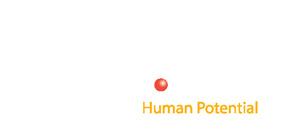
While many of your employees will embrace the idea of diversity, equity and inclusion (DEI), it’s not unusual for even the most inclusive organizations to face some pockets of resistance. Much of the solution lies in creating understanding, establishing trust and ensuring follow-through. In this article, we’ll look at strategies and explore ideas for engaging employees in the DEI process in a way that can help create broad commitment for lasting change.
Sincere commitment and collaborative action are the hallmarks of successful DEI programs in the workplace—ultimately building employee trust.
Deloitte
First, let’s take a look at what causes resistance and how to spot it in your organization. Recent research from Gartner offers some revelatory findings that can help to better understand and interpret the situation in your organization.
It starts with acknowledging that as organizational commitments to DEI have grown, “so has the pushback to DEI efforts. Forty-four percent of employees agree a growing number of their colleagues feel alienated by their organization’s DEI efforts, 42% of employees report their peers view their
organizations’ DEI efforts as divisive, and another 42% say their peers resent DEI efforts.”
So, what is the cause of this resistance? The short answer is fear—or what Gartner describes as “perceived threat” in these categories:
● Threat to individual identity: When individuals from dominant groups feel shamed or blamed, they may respond defensively to restore a positive sense of self.
● Threat to social identity: Dominant groups may push back if they feel targeted for their identities, sometimes citing “reverse discrimination.”
Gartner suggests that resistance often takes the form of denial with comments like “This is not a problem,” or disengagement “This is not my problem” or derailment “What about other problems?”
One of the best ways you can help employees embrace DEI is to root out resistance before it has a chance to take hold. A key way to do this? Be honest and forthright about what you are trying to accomplish and begin by taking an approach that makes everyone feel included and valued. Let’s look at five steps that can guide the way.
When faced with trying to embrace something new, it helps if we feel that we’re a part of it, rather than separate or like an “other.” One way to make this happen is to demystify DEI by tethering it back to basic human values that help establish common ground. You might start by using clear and simple language to explain DEI, such as:
● Diversity is about welcoming people of all types into the organization, including different cultures, religions, genders or other identities.
● Inclusion means ensuring that all employees feel included, and have a shared sense of purpose, belonging and appreciation.
● Equity is about fairness, offering help to those who need it, and creating a workplace where everyone has an opportunity to succeed.
The definitions above are just one way to interpret DEI, and there is no set standard that you must follow. Katica Roy, CEO of Pipeline Equity, a software company working to eradicate gender inequity, suggests choosing your own nomenclature when describing DEI.
How you refer to the work you’re doing to create a more diverse, equitable, and inclusive workplace depends on your company and your culture.
— Katica Roy, CEO of Pipeline Equity in Medium
The key message is that no one is excluded when it comes to DEI—and that everyone is part of a unique mix that makes up a diverse organization. It’s also equally as important to communicate what DEI is not about. It’s not about finger-pointing, shaming, blaming or otherwise vilifying any individuals or group of individuals.
As you develop and communicate your DEI plan, be clear about your reasons for launching the effort, explain what you want to achieve and why—working from the overriding premise that everyone benefits
from an inclusive culture. Share research showing that organizations and their employees can be more collaborative, innovative, productive and profitable when they are diverse, equitable and inclusive. Consider some thoughts shared by the Forbes Human Resource Council which cited 15 Key Benefits of DEI to Communicate With Team Members , including that..
● DEI helps all employees to feel safe, respected and connected
● Diverse teams have an increased ability to innovate faster
● A diverse and inclusive environment retains employees
● Highly inclusive companies are 120% more likely to hit their financial targets
How employees respond to your general approach can help you quickly spot any existing barriers to DEI, if you are not already aware of them. Take the time you need to be prepared with outreach that will thoughtfully address any points of resistance. For more guidance, see this article from HR.com, How to overcome employee resistance to DEI efforts.
A survey of more than 19,000 HBR readers found that “one particular culture style differentiated diverse and inclusive organizations from those that were not: a learning-oriented culture that emphasizes flexibility, open-mindedness, and exploration, and can equip organizations with the ability to adapt and innovate.”
A holistic DEI learning strategy is about more than reacting to today’s environment – it is about developing the conditions for long-term behavior changes. Deloitte
Cultivating this kind of learning culture includes shaping an educational plan that helps every employee and manager relate to the DEI effort in a personal and positive way. That includes offering training that feels inclusive and relatable, with specific tools and strategies that employees can
carry through to real life. But it’s important to realize that DEI is a journey that takes time, consistency and reinforcement. It’s a long-term commitment. For that reason, training is best when it provides time for selfreflection, meaningful follow-up and complementary initiatives—such as annual training interspersed with programs like mentorship, sponsorship or employee resource groups.
When we hear people share their stories in an authentic and compelling way, it builds a sense of understanding for their unique experiences. Stories help us transcend our own realities. They break down barriers because we as humans want and need to connect with each other. More than any other form of communication, storytelling can open our minds and enable us to embody someone else’s reality. It might be just for a few moments, but it can imprint onto our memories for a lifetime.
That’s why storytelling (real people sharing their experiences) is the best way to form interconnected ness—and helps us see that people can experience the same workplace in very different ways. Stories are a pathway to appreciating others and embracing DEI. But storytelling can also expose vulnerabilities, so you’ll want to introduce them with care in a safe environment where people have a chance to consider and reflect. If it is part of your training, then make sure that the stories are interwoven in a way that is thoughtful, sensitive and relatable.

One of the most important ways to help your employees to embrace DEI is to ensure that your
organization follows through on its commitments, that actions are concrete and tangible, and that communication is sincere and ongoing. If employees see demonstrable results, they will trust that the organization is not just talking about diversity, equity and inclusion, it is making changes that align with its values. That includes putting a focus on fairness through organizational systems, such as revamped recruitment, hiring and onboarding processes, equitable employee advancement and more inclusive meetings.
At the heart of it, DEI is more than a program. It’s within the fabric of the organization. That means that every decision, action and communication should take diversity, equity and inclusion into account. When employees feel that commitment from the organization, they will refract it back in a way that can lead to meaningful and transformative change.

Ultimately DEI can become an integral part of who we are, like the very air that we breathe, rather than something that is dealt with in a separate way. Once there, the benefits of DEI will be so evident that embracing them will be a natural part of creating a more inclusive, collaborative and productive organization that makes it possible for everyone to succeed.
Natasha Nicholson is Director, Content Marketing at Kantola Training Solutions, an innovative e-Learning company focused on Diversity, Equity, & Inclusion and Harassment Prevention training solutions. She is responsible for thought leadership, content strategy and production. Her background includes more than 20 years as a content leader, communication strategist and editor.
The modern employee engagement platform for the modern workforce.

Sterling, a leading provider of background and identity services, helps 47k+ global clients create people-first cultures and hire with confidence.
LEARN MORE
Art of Mentoring combines evidence-based mentoring expertise with the latest technological innovations to enable organisations to develop impactful, cost-effective mentoring programs.
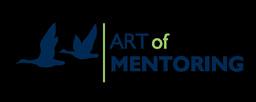
TRACOM is the leader in Social Intelligence training. We offer SOCIAL STYLE, Resilience, EQ and Agility assessments and training programs.
LEARN MORE
Reward Gateway helps companies engage, motivate and retain people – every day, all over the world. Our unified employee engagement hub provides the best of recognition, reward, wellbeing, surveys, benefits and discounts that support talent acquisition, retention and valuesdriven growth.
Founded with a single vision and purpose - Harrison helps companies optimize human capital by leveraging a deep understanding of human resources and psychology.

Momentive is a new type of agile experience management company that delivers intuitive, AI-powered solutions built for the pace of modern business.
We power the brave, curious, and ambitious who want to reshape their customer and employee experiences, products, industries—and our future.
We put people at the center of our technology, and we’re here to collaborate with those who advocate for equality.
Jobvite is a comprehensive talent acquisition suite that powers a marketing-inspired recruiting approach from first look to first day.
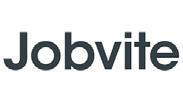
18,
19,
October 18, 2022
an Empathy Strategy© to Go
Benefits of Resilience
Paced
From Training to Thriving: Sharlyn Lauby’s
to a
October 19, 2022
October 20, 2022
October
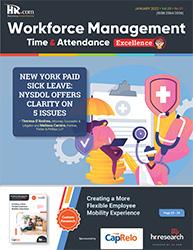
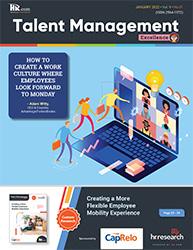
Informing, Educating, Enlightening and Assisting HR professionals in their personal and professional development, the Excellence series offers high-quality content through the publications!


